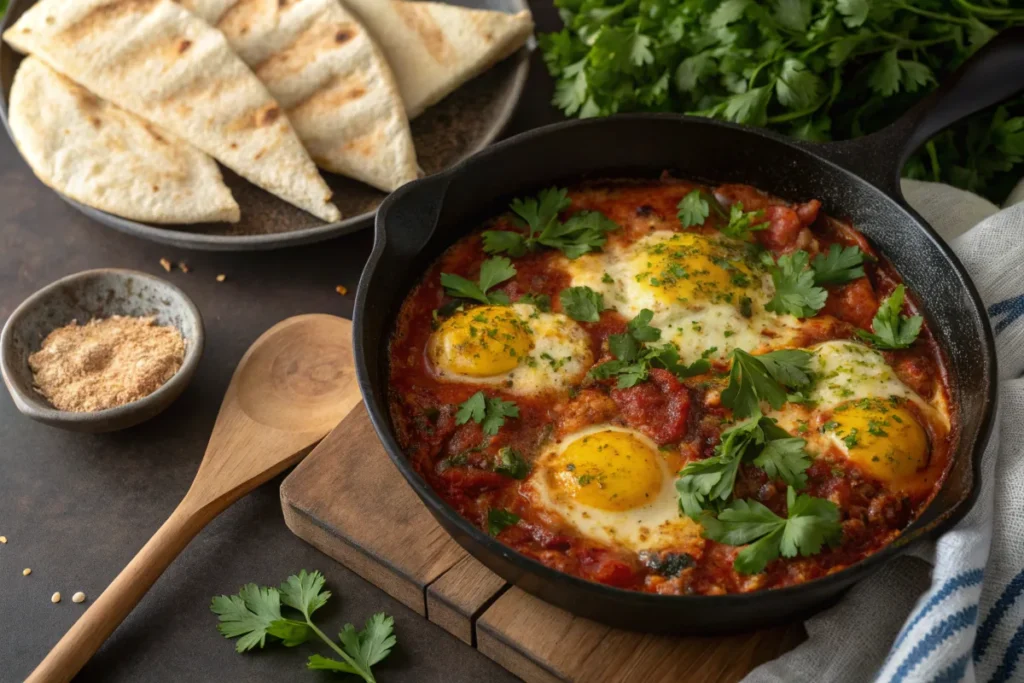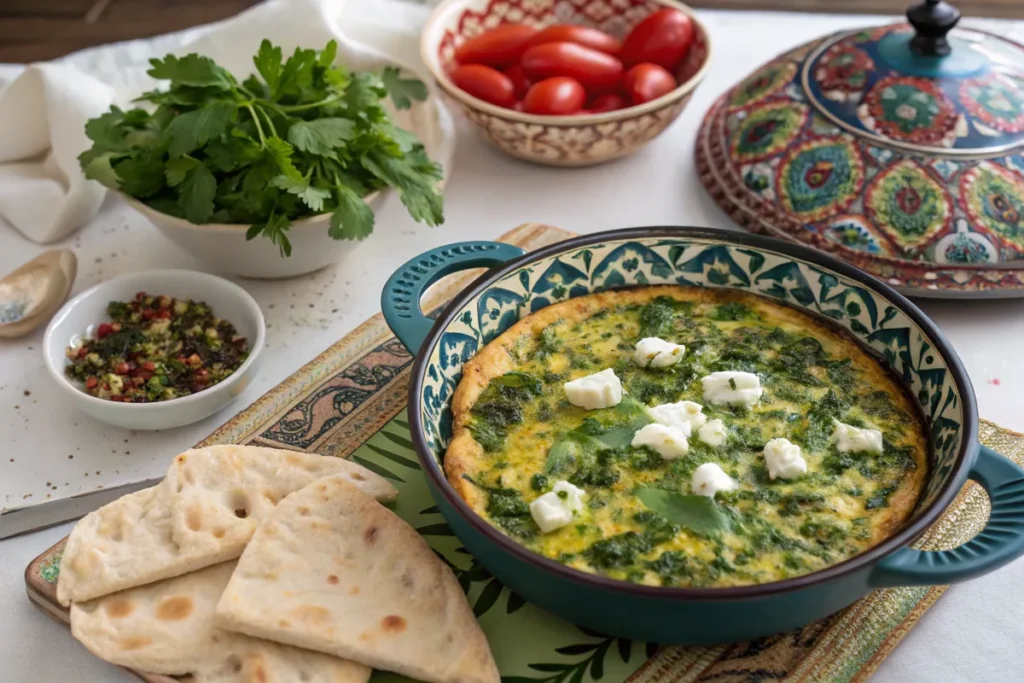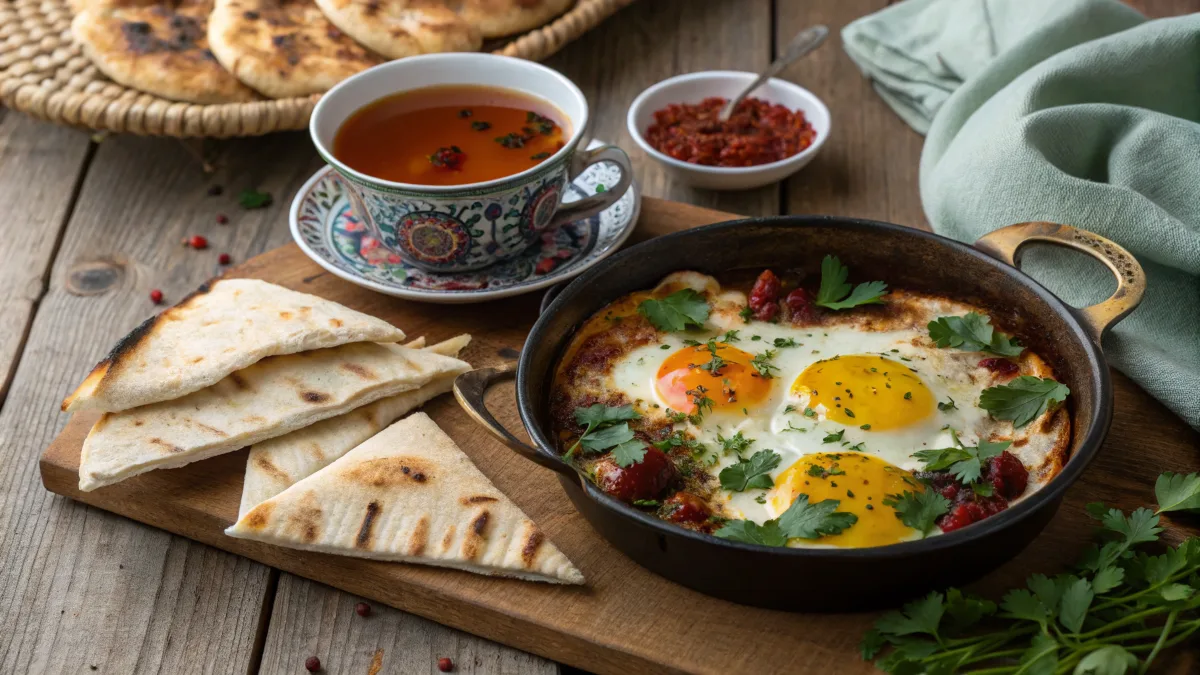A Persian egg breakfast is more than a meal. It shows Persian culture, hospitality, and cooking skills. This guide will explore its history, ingredients, popular recipes, and how you can recreate this comforting breakfast at home. From the vibrant flavors of turmeric to the pairing of fluffy eggs with crusty flatbreads, every bite tells a story. Whether you’re a food enthusiast or simply curious, there’s something here for everyone. Let’s dive in!
Table of Contents
What Is a Persian Egg Breakfast?
History of Persian Breakfast Traditions
Persian breakfasts are a feast for the senses. Traditionally, mornings in Iran are about more than fueling up for the day—they’re about savoring the moment. Families gather around a spread of warm flatbreads, fresh herbs, cheeses, and, of course, eggs cooked in a variety of ways. These meals are rooted in simplicity yet elevated by the use of fresh, flavorful ingredients.
Dating back centuries, Persian breakfasts were influenced by the availability of local produce and spices. Eggs, a readily available source of protein, quickly became a staple. Over time, dishes like Omelette Irani (Persian omelette) grew in popularity, showcasing how basic ingredients can create something extraordinary.
Introduction to Eggs in Persian Cuisine
In Persian cuisine, eggs symbolize nourishment and versatility. They’re used in many dishes, from simple scrambles to intricate recipes like Kuku Sabzi, a herbed egg frittata. What sets a Persian egg breakfast apart is the infusion of spices like turmeric, which adds warmth and depth, transforming ordinary eggs into a culinary masterpiece.
Eggs are often paired with tomatoes, onions, and herbs, creating a balance of textures and flavors. Whether soft and runny or fully cooked, the style varies based on personal preference, but the essence remains the same—a wholesome and delicious start to the day.
Key Ingredients in a Persian Egg Breakfast
Staple Ingredients: Eggs, Tomatoes, and Onions
The core of a Persian egg breakfast lies in its simplicity and flavor. Eggs are the star, whether lightly poached or fully cooked, depending on your preference. They are paired with ripe tomatoes, which provide a touch of natural sweetness and moisture to the dish. Onions add a depth of flavor and balance the tomatoes’ acidity.
In Persian omelettes like Omelette Irani, these staples are cooked to create a harmonious blend that embodies traditional Persian cooking techniques. The combination is versatile and can be adjusted by adding other vegetables or spices.
Flavor Enhancers: Turmeric and Olive Oil
A hallmark of Persian breakfasts is the use of turmeric. This vibrant golden spice not only enhances the dish with an earthy flavor but also adds anti-inflammatory benefits. It’s essential to fry turmeric in olive oil along with the onions to release its full aroma and mitigate its natural bitterness.
Extra virgin olive oil, a frequent choice in Persian kitchens, ensures a rich yet light base for the dish. Butter can also be used for a slightly creamier texture.
Persian Flatbread Pairings
No Persian egg breakfast is complete without traditional flatbreads like Noon Barbari or Sangak. These breads are perfect for scooping up the eggs and absorbing the richly flavored tomato sauce. If flatbreads are unavailable, any crusty bread makes an excellent alternative.
For more on global flatbread varieties, check out traditional breakfast breads.
Popular Persian Egg Recipes
Omelette Irani (Persian Omelette)
The Omelette Irani is a staple dish enjoyed in homes across Iran. This simple dish combines eggs, onions, tomatoes, and turmeric. It’s often cooked in a single skillet, making it an ideal choice for a quick, nutritious breakfast. The result is a soft, flavorful omelette that pairs beautifully with fresh herbs and bread.
Kuku Sabzi (Herbed Egg Frittata)
Another popular choice is Kuku Sabzi, a vibrant herbed egg frittata. Packed with parsley, dill, and cilantro, this dish is an aromatic celebration of Persian flavors. Unlike a traditional Western frittata, Kuku Sabzi uses a higher ratio of herbs to eggs, making it lighter and more fragrant.
Modern Takes on Persian Egg Breakfasts
For those looking to experiment, modern variations include adding feta cheese, chili flakes, or even smoked eggplant for a smoky twist. These updates retain the essence of a Persian egg breakfast while catering to contemporary tastes.
For an innovative breakfast idea, explore recipes inspired by global traditions, such as the Jamaican breakfast tacos.
Nutritional Benefits of Persian Egg Breakfasts
Rich in Protein and Antioxidants
The egg breakfast from Persia is basically protein-bound, which means it can serve as a perfect breakfast to start the day right. Eggs contain essential amino acids responsible for muscle health and repair. Antioxidants such as lycopene found in tomatoes help reduce oxidative stress and improve cardiovascular health.
Thus, the combination of protein and vegetables makes it a filling and nutritious meal to have with whole-grain flatbreads like Noon Barbari to provide the required energy for the morning.
Health Benefits of Turmeric in Breakfast
The standout ingredient of numerous Persian breakfasts is turmeric; this golden spice has somehow made its way into hearts for its anti-inflammatory and immunity-boosting properties. The efficacy of curcumin in supporting joint health and controlling the blood sugar levels might be a contributing factor.
To improve its effect, black pepper is always added, which increases the absorption of curcumin. This simple yet nutritious combination of adding turmeric and black pepper turns a Persian egg breakfast into a nutrient powerhouse!
For more insights into the health benefits of traditional dishes, consider exploring recipes like our grandma’s chicken soup.
How to Cook a Persian Egg Breakfast at Home
Step-by-Step Guide to Cooking Omelette Irani
Making a Persian egg breakfast like Omelette Irani is straightforward. Start by sautéing diced onions in olive oil until translucent. Add turmeric and cook briefly to release its aroma. Next, incorporate chopped ripe tomatoes, allowing them to soften and create a savory base.

Finally, crack the eggs directly into the skillet, keeping the yolks intact if desired. Cover with a lid and cook until the eggs reach your preferred consistency. Serve hot with fresh flatbread for a complete meal.
Tips for Choosing Fresh Ingredients
Freshness plays a crucial role in Persian cooking. Select tomatoes that are firm yet juicy and free-range eggs for the best flavor. When purchasing turmeric, opt for a high-quality spice to ensure its vibrant color and potency.
Alternative Cooking Methods for Variation
For a twist on the classic recipe, try baking the dish in a preheated oven for a frittata-style presentation. Alternatively, add herbs like parsley or dill to create a fusion between Omelette Irani and Kuku Sabzi. These variations are great for experimenting while keeping the essence of a Persian egg breakfast intact.
For additional recipe inspiration, check out our chicken chipotle melt for a flavorful breakfast alternative.
FAQs About Persian Egg Breakfast
What Is a Typical Persian Breakfast?
A traditional Persian breakfast often includes a variety of fresh and wholesome ingredients. Beyond the popular Persian egg breakfast, it typically features flatbreads like Noon Barbari or Sangak, creamy cheeses, fresh herbs, and sweet spreads such as honey or jam. Eggs, prepared in simple yet flavorful ways, remain a cornerstone, providing protein and richness to start the day.
What Is the Persian Egg Tradition?
The Persian egg tradition reflects the simplicity and creativity of Iranian cooking. Dishes like Omelette Irani highlight the use of everyday ingredients—eggs, tomatoes, and onions—transformed into a warm, satisfying meal. This tradition emphasizes fresh ingredients and slow, deliberate cooking techniques, making each dish a reflection of Persian culture and hospitality.
How Can I Make Persian Eggs More Exciting?
To elevate your Persian egg breakfast, try adding fresh herbs like parsley or dill for a burst of flavor. A sprinkle of feta cheese or a pinch of chili flakes can also add depth and spice. Experiment with side dishes such as pickled vegetables or olives to create a more diverse breakfast spread.
What’s the Most Luxurious Persian Breakfast Dish?
Among Persian breakfast options, Kuku Sabzi is considered both luxurious and flavorful. Packed with fresh herbs and cooked with delicate spices, it offers a fragrant and vibrant start to the day. Pairing this dish with saffron-infused tea adds an even more indulgent touch.
Persian Egg Breakfast Around the World
Variations in Different Middle Eastern Countries
A Persian egg breakfast shares similarities with other Middle Eastern dishes, yet it retains unique characteristics that set it apart. In neighboring countries like Turkey, dishes such as Menemen also combine eggs and tomatoes, but they often include green peppers and a spicier profile. Meanwhile, in Lebanon, Bayd bi Banadoura features a similar base but uses more garlic and fresh parsley.
The Persian version stands out due to its focus on turmeric and its simple preparation, which prioritizes the natural flavors of the ingredients. This makes it a distinctive choice for breakfast lovers worldwide.
Global Adaptations of Persian Egg Dishes
As the appeal of a Persian egg breakfast grows, it has inspired adaptations in various cuisines. Western versions may have toppings like avocado or crumbled goat cheese. Fusion recipes often use spices like paprika or cayenne for extra heat.

These global twists preserve the essence of the dish while introducing new textures and flavors, showcasing its versatility as a breakfast staple.
Wrapping Up the Persian Egg Breakfast Experience
Why It’s More Than Just a Meal
A Persian egg breakfast isn’t just about eating; it’s about enjoying the richness of tradition and culture. Each ingredient, from the golden turmeric to the soft Persian flatbreads, tells a story of simplicity and warmth. These breakfasts encourage connection, whether shared at a family table or recreated in a modern kitchen.
How to Start Your Own Persian Breakfast Tradition
Starting your own Persian breakfast tradition is easy and rewarding. Begin with a simple Omelette Irani and pair it with fresh bread and tea. As you grow comfortable, experiment with herbs, cheeses, or even fusion elements to make it your own.
For more delicious breakfast ideas, explore recipes like comforting Jamaican breakfast tacos or easy chicken pot pie. These dishes, though different, share the same heartwarming appeal of starting the day with flavorful, comforting food.

Persian Egg Breakfast
Ingredients
Method
- Sauté diced onions in olive oil until translucent.
- Add turmeric and cook briefly to release its aroma.
- Incorporate chopped ripe tomatoes and allow them to soften.
- Crack the eggs directly into the skillet, keeping yolks intact if desired.
- Cover with a lid and cook until the eggs reach your preferred consistency.
- Serve hot with fresh flatbread.

